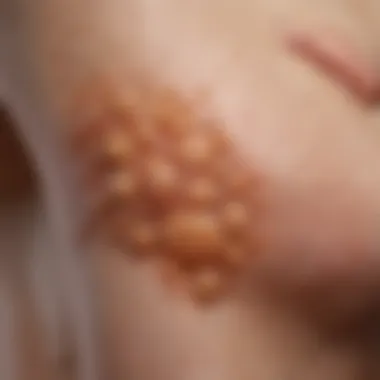Urticaria: In-Depth Insights on Hives and Treatment


Intro
Urticaria is a common yet intricate dermatological condition characterized by the abrupt emergence of itchy welts. These welts, often referred to as hives, can vary in size and can arise anywhere on the body. The condition can be acute or chronic, affecting both children and adults. Understanding this condition requires a comprehensive view that integrates its classifications, mechanisms, potential triggers, and treatment options.
This article aims to provide a detailed exploration of urticaria. Accurate diagnosis and management are paramount for those affected. Furthermore, a thorough review of the latest research trends offers insights into how this field is evolving. As we delve into the complexities of urticaria, we will discuss not only its medical implications but also its impact on the quality of life of individuals experiencing this condition.
Research Overview
Key Findings
Recent studies highlight the crucial link between urticaria and a variety of underlying factors. One of the main findings is that allergic responses are not the only triggers; physical stimuli, infections, and autoimmune responses can also play a significant role. This expanded understanding is vital for effective diagnosis and treatment.
Study Methodology
A variety of methodologies have been employed in current research. Studies often include patient interviews, skin prick tests, and serological analyses. These approaches help to identify not only the presence of classic allergens but also other potential triggers that may not be immediately apparent. This comprehensive approach aids in the creation of tailored treatment plans for patients.
Background and Context
Historical Background
Urticaria has been documented for centuries. Historical records indicate that the condition was recognized by early physicians, including Hippocrates. However, a detailed understanding of its causes and classifications has evolved gradually over time.
Current Trends in the Field
In recent years, there has been a shift towards personalized medicine. This focuses on understanding individual triggers and responses to treatment. Research now emphasizes the importance of a multidisciplinary approach involving dermatologists, allergists, and immunologists to provide optimal care.
Urticaria is more than just an itchy rash; it represents a complex interaction between the immune system, environmental factors, and the individual’s overall health. Recognizing this complexity is essential for advancing both understanding and management of the condition.
Prolusion to Urticaria
Understanding urticaria, commonly known as hives, is crucial for both patients and healthcare providers. This dermatological condition can cause significant discomfort and anxiety, affecting the quality of life for many individuals. A clear grasp of its definition, symptoms, and treatment options will enable a more effective management approach.
Definition and Overview
Urticaria is characterized by the sudden emergence of itchy welts on the skin, which can vary in size and shape. These welts are sometimes surrounded by a red flare. The condition can arise suddenly and may disappear within a few hours or persist for an extended period. The underlying mechanism typically involves the release of histamine from mast cells in the skin. This leads to increased vascular permeability, resulting in localized swelling and redness.
Prevalence and Clinical Significance
The prevalence of urticaria is not trivial. It is estimated that about 20% of people will experience urticaria at some point in their lives. While acute forms can resolve quickly, chronic urticaria poses a more prolonged challenge, lasting for six weeks or longer. This chronic condition can lead to considerable emotional distress and may disrupt daily activities. Its significance is underscored by the need for tailored diagnostic and management strategies that address the unique manifestations and triggers for each patient.
Classification of Urticaria
The classification of urticaria is significant in understanding the different forms and manifestations of this condition. Proper classification enables healthcare professionals to determine appropriate treatment options and predict outcomes. By distinguishing between acute, chronic, physical, and idiopathic urticaria, medical practitioners can tailor their approach to meet the specific needs of each patient. Each type has distinct triggers, durations, and underlying mechanisms, necessitating a nuanced understanding for effective management.
Acute Urticaria
Acute urticaria is characterized by its sudden onset and typically resolves within six weeks. The most common triggers include allergic reactions to food, medications, and insect bites. Patients often experience red, itchy welts that may vary in size. In severe cases, swelling can occur in deeper layers of skin, known as angioedema. Treatment typically involves antihistamines, which can alleviate symptoms. It is important to identify the root cause to prevent recurrence. Testing for allergies may be suggested if a specific trigger is suspected.
Chronic Urticaria
Chronic urticaria lasts longer than six weeks and may be spontaneous or inducible. Patients often report intermittent episodes of welts, which can be distressing and impact quality of life. Although the exact cause is often unknown, autoimmune responses, infections, and chronic illnesses may play roles. This type requires thorough clinical evaluation, as management often involves a combination of medications to control symptoms and address underlying causes. Keeping a symptom diary can also assist in tracking triggers and responses to treatment.
Physical Urticaria
Physical urticaria occurs when the skin reacts to specific stimuli, such as pressure, heat, cold, or sunlight. Each form may require unique management strategies. For example, someone with cold urticaria may have reactions to cold water or ice. Those facing pressure urticaria may find that wearing tight clothing triggers their symptoms. Recognizing the specific type of physical urticaria is essential to formulating effective avoidance strategies. In some cases, pre-medication with antihistamines before known triggers may be advised.
Idiopathic Urticaria
Idiopathic urticaria is when there is no identifiable cause for the symptoms. This type can be frustrating for both patients and providers since standard treatment may not always apply. Patients with idiopathic urticaria can experience chronic symptoms, which may lead to mental stress and anxiety. It is crucial to explore potential factors, including stress and diet, even when initial evaluations do not reveal clear triggers. Management often involves a stepwise approach, starting with first-line treatments and escalating as necessary.
Key Insight:
Effective classification of urticaria not only aids in treatment but also provides a framework for understanding a patient's specific situation, guiding further investigation and management.
Pathophysiology of Urticaria
Understanding the pathophysiology of urticaria provides significant insights into its management and treatment. This section will delve into the immune mechanisms and chemical mediators involved in the onset of urticaria, clarifying how these factors contribute to the characteristic symptoms of the condition. Recognizing these underlying processes emphasizes the complexity of urticaria and the necessity for targeted treatment approaches.


Immune System Involvement
The immune system plays a crucial role in the development of urticaria. In many cases, urticaria is associated with an hypersensitivity reaction. This reactions can involve various components of the immune response, particularly mast cells. Mast cells, which are present in skin tissues and other areas of the body, release a variety of inflammatory mediators upon activation. This release can occur due to various triggers, such as allergens or infections.
In chronic urticaria, the immune involvement might not be as clear-cut. For example, some patients may have autoantibodies that mistakenly activate mast cells, leading to persistent hives. This autoimmunity adds layers to the pathophysiological understanding. It creates a challenge for clinical diagnosis and requires thorough investigation. Such insights are essential for distinguishing between different urticaria types and tailoring individual treatment plans.
Role of Histamine and Other Mediators
Histamine is one of the primary mediators in urticaria. When mast cells degranulate due to immune activation, they release histamine into the surrounding tissues. This process ultimately leads to vasodilation and increased vascular permeability, creating the welts and itching associated with urticaria.
In addition to histamine, several other mediators are involved. These include leukotrienes, prostaglandins, and various cytokines. Each of these substances contribute to the inflammatory response and symptomatology of urticaria. Specific combinations of these mediators may vary among individuals, explaining why responses to treatment can differ.
It is also essential to understand that while antihistamines have a significant role in managing symptoms, they may not address all mediators. This oversight illustrates the need for continued research. Greater understanding of these underlying processes may lead to the development of more effective therapeutic strategies in the future.
"Recognizing the precise mechanisms behind urticaria not only aids in diagnosis but also in crafting effective management strategies."
The pathophysiology of urticaria portrays a complex interplay between the immune system and various mediators. This complexity underscores the importance of personalized management approaches, where awareness of individual patient characteristics can lead to better outcomes.
Common Triggers of Urticaria
Understanding the common triggers of urticaria is essential for both diagnosis and management. Identifying what stimulates the histamine release leading to welts can significantly enhance the quality of life for affected individuals. Different triggers affect different people, and awareness of these can inform avoidance strategies. This section delves into specific categories of triggers, encompassing allergic reactions, infections, environmental factors, and food-related causes.
Allergic Reactions
Allergic reactions are a prominent trigger of urticaria. When the immune system encounters an allergen—like pollen, pet dander, or certain medications—it may react by releasing histamine. This substance causes the blood vessels to expand, leading to the classic symptoms of hives.
Common allergens include:
- Medications such as antibiotics and non-steroidal anti-inflammatory drugs (NSAIDs)
- Insect stings or bites from bees and wasps
- Latex, which affects those with sensitivities
Recognizing these allergens can prompt faster intervention and alleviate symptoms.
Infections
Infections can also be a significant factor in triggering urticaria, especially in young children. Viral infections tend to be the most prevalent cause. For instance, illnesses such as the common cold or upper respiratory infections often coincide with hive outbreaks.
Key points regarding infections include:
- Viral infections are more frequently associated with acute urticaria.
- Bacterial infections, though less common, can also lead to hives.
Meticulous attention to one’s health history often reveals patterns linking infections to urticaria episodes, reinforcing the need for thorough clinical evaluations in such cases.
Environmental Triggers
Environmental factors play a critical role in the onset of urticaria. Variations in temperature and humidity can provoke skin reactions. Individuals may notice hives appearing after exposure to cold air or after sweating during physical activity. Environmental triggers often encompass:
- Temperature changes that include extremes of heat or cold
- Sunlight exposure, known as solar urticaria in some cases
- Pressure on the skin, as can occur from tight clothing or prolonged sitting
Awareness of how these elements can affect skin sensitivity is important for managing and preventing flare-ups.
Food-related Triggers
Food allergies are a common consideration for those experiencing urticaria. Various foods may elicit hives. These usually include:
- Shellfish, such as shrimp and crab
- Nuts, particularly peanuts and tree nuts
- Eggs and milk for those who have intolerances
In some instances, the association may not be about allergy but rather food additives or preservatives. Keeping a food diary can be instrumental for individuals to track their reactions and identify underlying triggers.
"Recognizing food-related triggers is vital, as dietary modifications can significantly reduce the frequency of urticaria episodes."
By thoroughly understanding and identifying these triggers, individuals can make informed choices to avoid or minimize exposure, thus reducing the impact of urticaria on their daily lives.
Diagnosis of Urticaria
Diagnosing urticaria is a critical step in managing the condition effectively. It involves a thorough evaluation of the patient's clinical history and the symptoms exhibited. Accurate diagnosis is essential to distinguish urticaria from other skin conditions that may present similar symptoms. Understanding the underlying cause of the welts can lead to tailored treatment strategies.
Effective diagnosis aids healthcare providers in determining whether the urticaria is acute or chronic and helps identify potential triggers. As triggers can vary widely, thorough investigation is necessary to guide subsequent management choices.


Clinical History and Symptoms
The clinical history is fundamental to diagnosing urticaria. Healthcare providers often begin by asking patients about their symptoms, including onset, duration, and frequency of the welts. Patients are typically questioned regarding any associated symptoms such as swelling, pain, or systemic reactions. Understanding the timing of the symptoms can provide important clues about potential triggers.
Certain factors in the patient’s lifestyle or medical history can also offer insight into the cause. For instance, a recent infection, new medications, or changes in diet may suggest specific allergic reactions. Providing a detailed history can significantly support accurate diagnosis.
Diagnostic Tests
Skin Prick Tests
Skin prick tests are a valuable tool in the diagnosis of urticaria. This test involves introducing small amounts of potential allergens into the skin. The skin's reaction is monitored to determine sensitivities.
One key characteristic of skin prick tests is their prompt results, usually within 15 to 20 minutes. This makes them a popular choice among clinicians. Skin prick tests can identify specific allergens, which is beneficial for creating an effective management plan.
However, there are drawbacks. If the patient is on antihistamines, it might interfere with the accuracy of the results. Additionally, some individuals might experience discomfort during the test.
Blood Tests
Blood tests provide another method to evaluate urticaria. These tests can help rule out conditions that may mimic urticaria or indicate underlying issues. Common blood tests include measuring levels of tryptase, which can be elevated during an allergic reaction.
Blood tests are less invasive than skin tests and can be particularly useful for patients who cannot undergo skin prick testing. They generally provide a broader picture of the patient’s overall health.
Nonetheless, blood tests might not pinpoint specific allergens as effectively as skin prick tests. Both tests serve unique purposes and contribute to a comprehensive assessment of urticaria.
Management and Treatment Strategies
The management and treatment of urticaria is essential due to the condition's significant impact on quality of life. Understanding how to effectively manage urticaria can lead not only to symptom relief but also to a reduction in triggers, improving overall well-being. This section will analyze various strategies, including medication options, alternative therapies, and lifestyle modifications.
Antihistamines
Antihistamines are the cornerstone of urticaria management. These medications work by blocking histamine, a substance that contributes to allergic reactions and skin symptoms. They effectively reduce itchiness and the formation of hives.
Both first-generation antihistamines, such as diphenhydramine, and second-generation antihistamines, like cetirizine and loratadine, are used. The difference lies in their sedative effects. First-generation options can cause drowsiness, while second-generation ones are typically non-sedating, making them more suitable for daily use.
Patients often experience relief within hours. However, some may require higher doses or a combination of different antihistamines for chronic urticaria. Regular follow-up with healthcare professionals is vital to reevaluate the treatment effectiveness and make necessary adjustments.
Alternative Therapies
Alternative therapies may provide additional support for patients with urticaria who do not respond completely to conventional treatments. Although less researched, certain approaches have shown promise. For certain individuals, acupuncture has been suggested to relieve symptoms, while herbal supplements like butterbur or quercetin may help reduce inflammation.
Mind-body techniques such as yoga and mindfulness meditation can also be beneficial. These practices aim to mitigate stress, which can exacerbate symptoms for some patients.
Before starting any alternative therapy, it is important for patients to discuss these options with their healthcare provider. Each therapy should be considered individually, as responses can vary.
Avoidance Strategies
Avoiding known triggers plays a crucial role in managing urticaria. Many patients find success by identifying and eliminating specific allergens or irritants that provoke their symptoms. A detailed history or an elimination diet may help pinpoint these triggers. Common avoidance strategies include:
- Dietary management: Keeping a food diary to track and identify reactive foods
- Environmental control: Reducing exposure to known allergens such as pollen, pet dander, or dust mites
- Medication review: Discussing current medications with a doctor to avoid known triggers
It is also important for individuals to maintain an awareness of their physical environment and stress levels. Simple lifestyle changes can make a significant difference.
"A comprehensive approach combining these management strategies enhances overall treatment effectiveness and quality of life for patients with urticaria."
Impact on Quality of Life
Understanding the impact of urticaria on quality of life is crucial. This condition can significantly affect individuals both physically and emotionally. The severity and frequency of urticaria attacks can lead to discomfort, anxiety, and confusion. Individuals potentially face disruptions in their daily activities, work, and relationships. Evaluating how urticaria changes a person’s routine helps both patients and healthcare providers to appreciate the broader implications of this condition.
Psychological Effects
Urticaria’s psychological burden often goes unnoticed. The visibility of hives can lead to social withdrawal or embarrassment. Patients may experience feelings of frustration and helplessness due to the unpredictable nature of outbreaks. Mental health issues such as anxiety and depression are more common in those suffering from chronic urticaria. Support from mental health professionals might be necessary to help patients cope effectively with their condition.
A few key aspects to consider include:
- Social Interaction: Fear of outbreaks in social gatherings may cause individuals to avoid activities.
- Body Image: Visible marks from urticaria can lead to negative body image and self-esteem issues.
- Stress Management: Increased stress levels can trigger outbreaks, creating a cycle of worsening mental health and worsening symptoms.


"Understanding the psychological aspects of urticaria can lead to comprehensive therapeutic strategies that encompass both physical and emotional well-being."
Daily Life Challenges
Daily life for individuals with urticaria can be particularly challenging. Tasks that seem routine to most may become sources of discomfort. The need to constantly manage symptoms influences various aspects of life, making it essential to recognize these challenges.
Several challenges might arise, such as:
- Limitation of Activities: Physical activities can be restricted based on the likelihood of triggering an episode.
- Sleep Disruptions: The itching caused by hives often interferes with restful sleep, leading to further fatigue.
- Impact on Work: Frequent medical appointments or unplanned absences from work can affect job performance and relationships with colleagues.
Individuals diagnosed with urticaria must often develop coping mechanisms. These may include:
- Keeping a symptom diary to identify triggers.
- Following a tailored treatment plan to reduce outbreaks.
- Engaging in relaxation techniques to alleviate stress associated with the condition.
Current Research Trends
Research trends play a crucial role in understanding urticaria, its management, and potential future therapies. The dynamics of medical science are always evolving, and keeping pace with these changes is vital for effective treatment and patient care. Current studies are focused on unraveling the complexities of chronic urticaria and identifying innovative treatment approaches that improve patient outcomes.
Innovative Treatment Approaches
Innovation in treatment strategies is essential to manage urticaria effectively. Recent research has identified the potential of biologics as a targeted therapy, especially for chronic cases that do not respond to conventional antihistamines. Drugs like omalizumab, which acts as a monoclonal antibody targeting IgE, have shown promising results. Utilizing a multi-faceted approach to treatment can lead to improved quality of life for patients.
"There has been a notable shift from traditional treatments to more personalized medicine in chronic urticaria management."
Additionally, ongoing clinical trials are exploring the efficacy of additional biologics, such as dupilumab, in treating chronic urticaria. These advancements reflect a tailored approach to treatment, emphasizing the need for ongoing monitoring and adaptation of therapeutic strategies.
Understanding Chronic Urticaria
Chronic urticaria presents unique challenges compared to its acute counterpart. Research stresses the importance of pinpointing underlying causes, which can be autoimmunological or idiopathic. As a result, studies are increasingly focusing on the role of the immune system in chronic urticaria. Analyzing specific immune markers may aid in providing targeted therapies and more accurate diagnoses.
Furthermore, understanding the psychological impact of chronic urticaria is gaining traction. Evidence suggests that chronic hives can lead to significant anxiety and depression, affecting patients' overall quality of life. Ongoing research is aimed at integrating mental health support into treatment plans to ensure holistic patient care.
Future Directions in Urticaria Research
The study of urticaria is evolving. As our understanding deepens, new approaches to treatment and management are emerging. This section examines the future directions in urticaria research. Insights into upcoming therapies, as well as interdisciplinary studies, can potentially enhance patient care and outcomes.
Emerging Therapies
Research is focusing on innovative therapies that could offer better control of urticaria symptoms. Current antihistamines remain the backbone of treatment, but limitations exist. Thus, researchers are exploring several avenues:
- Biologics: These are targeted therapies that could modify immune responses. Omalizumab, for instance, has shown promise in chronic spontaneous urticaria, allowing many patients to experience relief.
- Janus kinase (JAK) inhibitors: These oral medications may regulate pathways involved in immune response and inflammation, providing another potential avenue for effective management.
- Monoclonal antibodies: Other monoclonal antibodies are also being studied for their role in urticaria. Their specificity could minimize side effects and improve treatment efficacy.
These novel therapies may lead to more personalized and effective management strategies, offering hope for those with severe or persistent urticaria.
Interdisciplinary Studies
The complex nature of urticaria calls for interdisciplinary studies. Collaboration between dermatologists, immunologists, allergists, and researchers can yield comprehensive insights. Such studies can help address multifaceted aspects:
- Mechanisms of disease: A better understanding of the underlying mechanisms is vital. Research that combines different specialties can lead to breakthroughs.
- Patient management: Understanding how different medical fields approach diagnosis and treatment can enrich patient care. This holistic perspective can improve patient outcomes.
- Patient experiences: Qualitative studies examining patient experiences of living with urticaria can guide clinical practice. Insights gained can shape tailored interventions that meet patient needs.
Interdisciplinary collaboration has the potential to greatly advance our understanding of urticaria, leading to more effective strategies and support for patients.
As research continues to progress, the impact of these emerging therapies and comprehensive studies will shape the future of urticaria management. The goal is to not only alleviate symptoms but also improve the overall quality of life for those affected by this condition.
Epilogue and Key Takeaways
In the field of dermatology, understanding urticaria is crucial due to its prevalence and impact on quality of life. This condition goes beyond mere discomfort; it can severely affect daily activities, psychological well-being, and overall health. The exploration of urticaria in this article highlights how the condition is multifaceted, requiring a deep understanding for effective diagnosis and management.
Summary of Findings
Urticaria is a complex condition characterized by the presence of itchy welts on the skin. It can be classified into various types, including acute, chronic, physical, and idiopathic urticaria. Each type has distinct triggers, ranging from allergic reactions to environmental factors. The pathophysiological mechanisms reveal significant involvement of the immune system, specifically the release of histamine and other mediators.
The triggers identified play a key role in their management. Many patients can manage their symptoms by recognizing and avoiding specific triggers. The treatments can vary widely, with antihistamines being the first line of defense. Alternative therapies may provide benefits for some individuals. Overall, accurate diagnosis is essential for a tailored approach to treatment.
Implications for Practice
For practitioners, the knowledge gained from this comprehensive exploration of urticaria should be applied in clinical settings to improve patient care. Understanding the diverse nature of urticaria, alongside its psychosocial impacts, reinforces the need for personalized management plans.
- Importance of Accurate Diagnosis: Misdiagnosis can lead to ineffective treatments. A thorough clinical history and appropriate diagnostic tests are critical.
- Patient Education: Educating patients on recognizing triggers and understanding their condition can foster a proactive approach to management.
- Interdisciplinary Collaboration: Urticaria may intersect with other health disciplines. Referral systems can enhance patient outcomes by facilitating comprehensive care.
By synthesizing the findings presented, health professionals can better navigate the complexities of urticaria, providing informed recommendations that prioritize patient well-being.
"A detailed understanding of urticaria empowers patients and practitioners alike, paving the way for improved management and quality of life."







